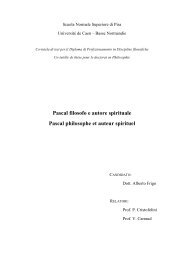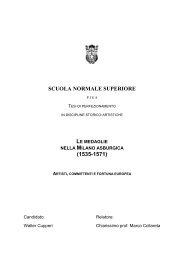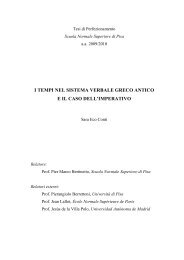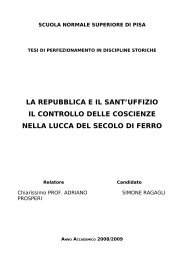CATULLUS 68 - Scuola Normale Superiore
CATULLUS 68 - Scuola Normale Superiore
CATULLUS 68 - Scuola Normale Superiore
Create successful ePaper yourself
Turn your PDF publications into a flip-book with our unique Google optimized e-Paper software.
for a shipwrecked man but must be accompanied by a specific reference to shipwreck (“necessario …<br />
adiciendum esse, quo agi de naufragio appareat”); consequently he conjectures haustis, which was<br />
subsequently re-proposed by Herzog (1936: 346-348). But haustis is unconvincing because as a perfect<br />
participle it would have to mean not ‘drowning’ but ‘drowned’, ‘submerged’, ‘swallowed by the sea’, as at<br />
Ov. Fast. 3.599f. figitur ad Laurens ingenti flamine litus / puppis et expositis omnibus hausta perit, Liv.<br />
33.41.7 multae eiectae naues, multae ita haustae mari, ut nemo in terram enaret and Tac. Hist. 1.2 haustae<br />
aut obrutae urbes. As for terram dare, it is not attested in this or in any other sense before Vulg. Ezech. 45.8<br />
sed terram dabunt domui Israhel secundum tribus eorum. This casts doubt altogether on the reading terram<br />
dedit and rules out a series of more or less ingenious reconstructions: terram dedit, ubertim (Wetstein:<br />
ingenious but too far from the transmitted aufert), terram dedit audens (Friedrich), terram dedit ac uer<br />
(Walter 1940) and terram dedit Allius (Viejo Otero 1943: 129f., which would be impossible anyway since<br />
Allius has already been greeted in line 155). On the other hand, terram dedit, or terram dedit aufertque,<br />
could well be the conjecture of a pious reader from the Middle Ages. In this case the transmitted text need<br />
not be too close to the original reading – which could be te tradidit, or anything else.<br />
There have been proposed a considerable number of other emendations for terram dedit. It is probably best<br />
to start with a pair of relatively similar reconstructions. Avantius wrote the distich as follows in the first<br />
Aldine edition of 1502 (we have already dismissed his reconstruction of the start of the hexameter):<br />
et qui principio nobis dominam dedit, a quo<br />
sunt primo omnia nata bona<br />
Meanwhile, Perrotta (1927: 145-148) built upon an idea that he found in a humanistic codex (perhaps the<br />
Bologna codex 8, in which the second hand added the readings of the first Aldine or a similar edition) and<br />
proposed the following:<br />
et qui principio nobis se et eram dedit, a quo<br />
sunt primo omnia nata bona<br />
The key idea of these two reconstructions is the repetition of nobis: used originally by the poet in both lines<br />
of this distich, it would have dropped out from the pentameter due to a sort of haplography, a quo would<br />
have been moved from the end of the hexameter to the start of the pentameter to make it metrically complete,<br />
and a complex series of corruptions would have given the hexameter the shape that it has in the principal<br />
MSS. However, this raises several problems. First of all, haplography tends to work in a very different way:<br />
one of a pair of similar words tends to be omitted along with the intervening text, as happened in X at Cat.<br />
92.2-4. Moreover, it is not likely that Catullus should have used twice within the same distich the bland word<br />
nobis for no tangible reason (contrast lines 41f. qua me Allius in re / iuuerit aut quantis iuuerit officiis). Nor<br />
257






